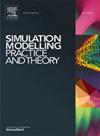地铁站客流控制措施的仿真自适应优化
IF 3.5
2区 计算机科学
Q2 COMPUTER SCIENCE, INTERDISCIPLINARY APPLICATIONS
引用次数: 0
摘要
有效的客流控制措施对地铁站的安全运营至关重要。现有的站内控制措施包括调整自动扶梯的运行模式和设置临时围栏。然而,在实际操作中,地铁运营商往往会在固定时段采用固定的运行模式,这表明目前地铁站内的客流控制措施过于僵化。因此,开发一种自适应控制策略来不断平衡剧烈波动的客流并优化运营性能是当前研究的一个关键问题。本研究选择运输效率和拥堵风险作为客流运输风险的评价目标,并将客流特征、车站结构和客流控制措施作为关键影响因素。随后,提出了一种集模拟和数据插值于一体的自适应优化方法。利用软件 Legion 进行 150 次正交模拟,通过对模拟结果进行数据插值,得到客运风险预测模型。最后,以某地铁站为例,通过场景获取、风险识别、自适应决策等方法,得到了任意客流构成下的最优客流控制策略。结果表明,设置临时围栏可以降低检票口附近的客流密度,而调整自动扶梯的运行方向则可以减少站台上的拥挤现象。在客流构成变化的情况下,可以得到当前场景下的最优策略,将客运风险控制在可接受的范围内,为地铁运营商的决策提供帮助。本文章由计算机程序翻译,如有差异,请以英文原文为准。
Simulation-based adaptive optimization for passenger flow control measures at metro stations
Effective passenger flow control measures are essential for the safe operation of metro stations. Existing in-station control measures include adjusting the operation mode of escalators and setting up temporary fences. However, in practice, metro operators often adopt fixed operation modes during fixed periods, indicating that the current passenger flow control measures at metro stations are overly rigidified. Therefore, developing an adaptive control strategy to constantly balance the wildly fluctuating passenger flow and optimize the operation performance is a key issue in current research. In this study, transportation efficiency and congestion risk are selected as evaluation objectives for passenger transportation risk, and passenger flow feature, station structure, and passenger flow control measures are considered key influential factors. Subsequently, an adaptive optimization method integrating simulation and data interpolation is proposed. The software Legion is used to conduct 150 orthogonal simulations, and prediction models for passenger transportation risk are obtained by performing data interpolation on the simulation results. Finally, taking a certain metro station as a case study, the optimal passenger flow control strategy under any passenger flow composition is obtained by scenario acquisition, risk identification, and adaptive decision-making. The results show that setting up temporary fences can reduce the passenger density near the fare gates, while adjusting the running direction of escalators can reduce overcrowding on the platform. Under varying passenger flow composition, the optimal strategy for the current scenario can be obtained, controlling passenger transportation risk within an acceptable range and providing assistance for metro operators in decision-making.
求助全文
通过发布文献求助,成功后即可免费获取论文全文。
去求助
来源期刊

Simulation Modelling Practice and Theory
工程技术-计算机:跨学科应用
CiteScore
9.80
自引率
4.80%
发文量
142
审稿时长
21 days
期刊介绍:
The journal Simulation Modelling Practice and Theory provides a forum for original, high-quality papers dealing with any aspect of systems simulation and modelling.
The journal aims at being a reference and a powerful tool to all those professionally active and/or interested in the methods and applications of simulation. Submitted papers will be peer reviewed and must significantly contribute to modelling and simulation in general or use modelling and simulation in application areas.
Paper submission is solicited on:
• theoretical aspects of modelling and simulation including formal modelling, model-checking, random number generators, sensitivity analysis, variance reduction techniques, experimental design, meta-modelling, methods and algorithms for validation and verification, selection and comparison procedures etc.;
• methodology and application of modelling and simulation in any area, including computer systems, networks, real-time and embedded systems, mobile and intelligent agents, manufacturing and transportation systems, management, engineering, biomedical engineering, economics, ecology and environment, education, transaction handling, etc.;
• simulation languages and environments including those, specific to distributed computing, grid computing, high performance computers or computer networks, etc.;
• distributed and real-time simulation, simulation interoperability;
• tools for high performance computing simulation, including dedicated architectures and parallel computing.
 求助内容:
求助内容: 应助结果提醒方式:
应助结果提醒方式:


